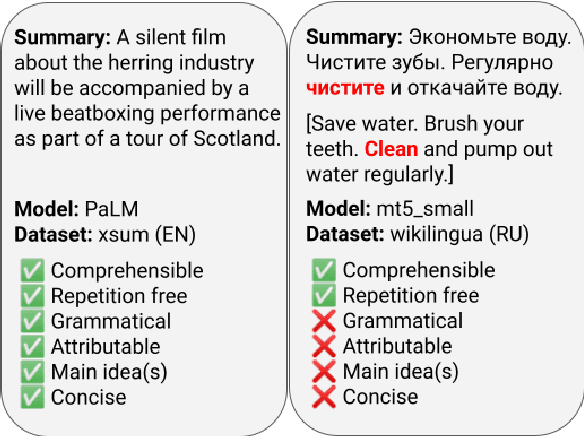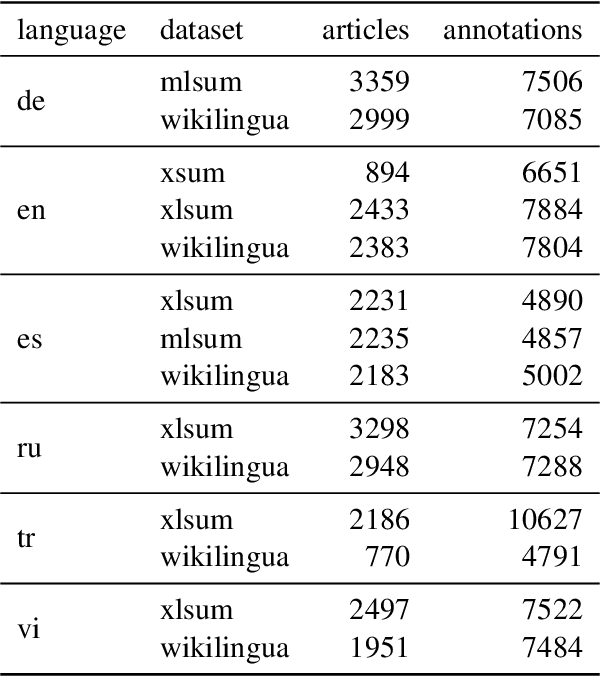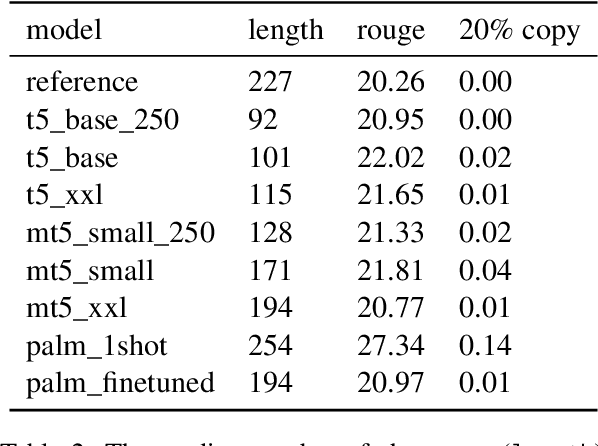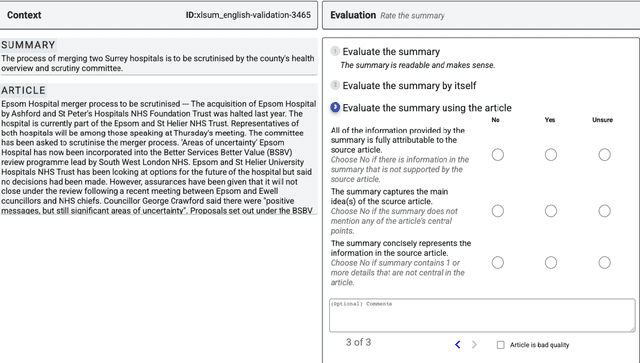Dipanjan Das
The FACTS Grounding Leaderboard: Benchmarking LLMs' Ability to Ground Responses to Long-Form Input
Jan 06, 2025



Abstract:We introduce FACTS Grounding, an online leaderboard and associated benchmark that evaluates language models' ability to generate text that is factually accurate with respect to given context in the user prompt. In our benchmark, each prompt includes a user request and a full document, with a maximum length of 32k tokens, requiring long-form responses. The long-form responses are required to be fully grounded in the provided context document while fulfilling the user request. Models are evaluated using automated judge models in two phases: (1) responses are disqualified if they do not fulfill the user request; (2) they are judged as accurate if the response is fully grounded in the provided document. The automated judge models were comprehensively evaluated against a held-out test-set to pick the best prompt template, and the final factuality score is an aggregate of multiple judge models to mitigate evaluation bias. The FACTS Grounding leaderboard will be actively maintained over time, and contains both public and private splits to allow for external participation while guarding the integrity of the leaderboard. It can be found at https://www.kaggle.com/facts-leaderboard.
Task Planning for Object Rearrangement in Multi-room Environments
Jun 01, 2024



Abstract:Object rearrangement in a multi-room setup should produce a reasonable plan that reduces the agent's overall travel and the number of steps. Recent state-of-the-art methods fail to produce such plans because they rely on explicit exploration for discovering unseen objects due to partial observability and a heuristic planner to sequence the actions for rearrangement. This paper proposes a novel hierarchical task planner to efficiently plan a sequence of actions to discover unseen objects and rearrange misplaced objects within an untidy house to achieve a desired tidy state. The proposed method introduces several novel techniques, including (i) a method for discovering unseen objects using commonsense knowledge from large language models, (ii) a collision resolution and buffer prediction method based on Cross-Entropy Method to handle blocked goal and swap cases, (iii) a directed spatial graph-based state space for scalability, and (iv) deep reinforcement learning (RL) for producing an efficient planner. The planner interleaves the discovery of unseen objects and rearrangement to minimize the number of steps taken and overall traversal of the agent. The paper also presents new metrics and a benchmark dataset called MoPOR to evaluate the effectiveness of the rearrangement planning in a multi-room setting. The experimental results demonstrate that the proposed method effectively addresses the multi-room rearrangement problem.
DOLOMITES: Domain-Specific Long-Form Methodical Tasks
May 09, 2024Abstract:Experts in various fields routinely perform methodical writing tasks to plan, organize, and report their work. From a clinician writing a differential diagnosis for a patient, to a teacher writing a lesson plan for students, these tasks are pervasive, requiring to methodically generate structured long-form output for a given input. We develop a typology of methodical tasks structured in the form of a task objective, procedure, input, and output, and introduce DoLoMiTes, a novel benchmark with specifications for 519 such tasks elicited from hundreds of experts from across 25 fields. Our benchmark further contains specific instantiations of methodical tasks with concrete input and output examples (1,857 in total) which we obtain by collecting expert revisions of up to 10 model-generated examples of each task. We use these examples to evaluate contemporary language models highlighting that automating methodical tasks is a challenging long-form generation problem, as it requires performing complex inferences, while drawing upon the given context as well as domain knowledge.
Anticipate & Collab: Data-driven Task Anticipation and Knowledge-driven Planning for Human-robot Collaboration
Apr 04, 2024



Abstract:An agent assisting humans in daily living activities can collaborate more effectively by anticipating upcoming tasks. Data-driven methods represent the state of the art in task anticipation, planning, and related problems, but these methods are resource-hungry and opaque. Our prior work introduced a proof of concept framework that used an LLM to anticipate 3 high-level tasks that served as goals for a classical planning system that computed a sequence of low-level actions for the agent to achieve these goals. This paper describes DaTAPlan, our framework that significantly extends our prior work toward human-robot collaboration. Specifically, DaTAPlan planner computes actions for an agent and a human to collaboratively and jointly achieve the tasks anticipated by the LLM, and the agent automatically adapts to unexpected changes in human action outcomes and preferences. We evaluate DaTAPlan capabilities in a realistic simulation environment, demonstrating accurate task anticipation, effective human-robot collaboration, and the ability to adapt to unexpected changes. Project website: https://dataplan-hrc.github.io
Gemini: A Family of Highly Capable Multimodal Models
Dec 19, 2023Abstract:This report introduces a new family of multimodal models, Gemini, that exhibit remarkable capabilities across image, audio, video, and text understanding. The Gemini family consists of Ultra, Pro, and Nano sizes, suitable for applications ranging from complex reasoning tasks to on-device memory-constrained use-cases. Evaluation on a broad range of benchmarks shows that our most-capable Gemini Ultra model advances the state of the art in 30 of 32 of these benchmarks - notably being the first model to achieve human-expert performance on the well-studied exam benchmark MMLU, and improving the state of the art in every one of the 20 multimodal benchmarks we examined. We believe that the new capabilities of Gemini models in cross-modal reasoning and language understanding will enable a wide variety of use cases and we discuss our approach toward deploying them responsibly to users.
SEAHORSE: A Multilingual, Multifaceted Dataset for Summarization Evaluation
May 22, 2023



Abstract:Reliable automatic evaluation of summarization systems is challenging due to the multifaceted and subjective nature of the task. This is especially the case for languages other than English, where human evaluations are scarce. In this work, we introduce SEAHORSE, a dataset for multilingual, multifaceted summarization evaluation. SEAHORSE consists of 96K summaries with human ratings along 6 quality dimensions: comprehensibility, repetition, grammar, attribution, main ideas, and conciseness, covering 6 languages, 9 systems and 4 datasets. As a result of its size and scope, SEAHORSE can serve both as a benchmark to evaluate learnt metrics, as well as a large-scale resource for training such metrics. We show that metrics trained with SEAHORSE achieve strong performance on the out-of-domain meta-evaluation benchmarks TRUE (Honovich et al., 2022) and mFACE (Aharoni et al., 2022). We make SEAHORSE publicly available for future research on multilingual and multifaceted summarization evaluation.
Text-Blueprint: An Interactive Platform for Plan-based Conditional Generation
Apr 28, 2023Abstract:While conditional generation models can now generate natural language well enough to create fluent text, it is still difficult to control the generation process, leading to irrelevant, repetitive, and hallucinated content. Recent work shows that planning can be a useful intermediate step to render conditional generation less opaque and more grounded. We present a web browser-based demonstration for query-focused summarization that uses a sequence of question-answer pairs, as a blueprint plan for guiding text generation (i.e., what to say and in what order). We illustrate how users may interact with the generated text and associated plan visualizations, e.g., by editing and modifying the blueprint in order to improve or control the generated output. A short video demonstrating our system is available at https://goo.gle/text-blueprint-demo.
Attributed Question Answering: Evaluation and Modeling for Attributed Large Language Models
Dec 15, 2022



Abstract:Large language models (LLMs) have shown impressive results across a variety of tasks while requiring little or no direct supervision. Further, there is mounting evidence that LLMs may have potential in information-seeking scenarios. We believe the ability of an LLM to attribute the text that it generates is likely to be crucial for both system developers and users in this setting. We propose and study Attributed QA as a key first step in the development of attributed LLMs. We develop a reproducable evaluation framework for the task, using human annotations as a gold standard and a correlated automatic metric that we show is suitable for development settings. We describe and benchmark a broad set of architectures for the task. Our contributions give some concrete answers to two key questions (How to measure attribution?, and How well do current state-of-the-art methods perform on attribution?), and give some hints as to how to address a third key question (How to build LLMs with attribution?).
QAmeleon: Multilingual QA with Only 5 Examples
Nov 15, 2022Abstract:The availability of large, high-quality datasets has been one of the main drivers of recent progress in question answering (QA). Such annotated datasets however are difficult and costly to collect, and rarely exist in languages other than English, rendering QA technology inaccessible to underrepresented languages. An alternative to building large monolingual training datasets is to leverage pre-trained language models (PLMs) under a few-shot learning setting. Our approach, QAmeleon, uses a PLM to automatically generate multilingual data upon which QA models are trained, thus avoiding costly annotation. Prompt tuning the PLM for data synthesis with only five examples per language delivers accuracy superior to translation-based baselines, bridges nearly 60% of the gap between an English-only baseline and a fully supervised upper bound trained on almost 50,000 hand labeled examples, and always leads to substantial improvements compared to fine-tuning a QA model directly on labeled examples in low resource settings. Experiments on the TyDiQA-GoldP and MLQA benchmarks show that few-shot prompt tuning for data synthesis scales across languages and is a viable alternative to large-scale annotation.
Query Refinement Prompts for Closed-Book Long-Form Question Answering
Oct 31, 2022Abstract:Large language models (LLMs) have been shown to perform well in answering questions and in producing long-form texts, both in few-shot closed-book settings. While the former can be validated using well-known evaluation metrics, the latter is difficult to evaluate. We resolve the difficulties to evaluate long-form output by doing both tasks at once -- to do question answering that requires long-form answers. Such questions tend to be multifaceted, i.e., they may have ambiguities and/or require information from multiple sources. To this end, we define query refinement prompts that encourage LLMs to explicitly express the multifacetedness in questions and generate long-form answers covering multiple facets of the question. Our experiments on two long-form question answering datasets, ASQA and AQuAMuSe, show that using our prompts allows us to outperform fully finetuned models in the closed book setting, as well as achieve results comparable to retrieve-then-generate open-book models.
 Add to Chrome
Add to Chrome Add to Firefox
Add to Firefox Add to Edge
Add to Edge